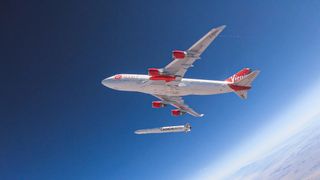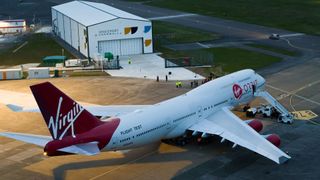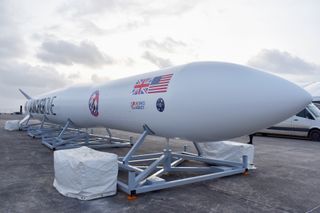Virgin Orbit: Facts about the bankrupt air-launch provider
In an increasingly competitive commercial space sector driven by billionaires with lofty ambitions, Virgin Orbit stood out from the rest with a novel air-launch system.

Virgin Orbit was a US-based private commercial small satellite launch provider operated by the British multinational conglomerate Virgin Group.
The company filed for bankruptcy in early April 2023 and has agreed to sell key assets worth over $35 million to three aerospace companies: Stratolaunch, Rocket Lab and Launcher. Virgin Orbit has now ceased operations.
The company was formed in 2017 as a spin-off from Virgin Group's other spacefaring venture Virgin Galactic, which primarily offers space tourism services.
In the increasingly competitive commercial spaceflight sector, Virgin Orbit was known for its horizontal air-launch system in which an expendable two-stage LauncherOne rocket was carried to around 35,000 ft by a modified Boeing 747-400 passenger plane called Cosmic Girl — also operated by Virgin Orbit. LauncherOne was then released and used one Newton engine per stage to reach its desired orbit and deliver its payload.
Related: Virgin Galactic: Richard Branson's space tourism company
Virgin Orbit launches
As of 23 January 2023, Virgin Orbit had carried out six missions, including two demonstrations, with the LauncherOne rocket. Four of the six missions were successful.
After the first two demonstration missions, Virgin Orbit began naming missions after songs — three of which were released through Virgin Group's former record label Virgin Records.
- May. 25, 2020. Mojave Air and Space Port, California: Launch Demo
This mission was the maiden orbital flight of the LauncherOne rocket. After successful release over the Pacific Ocean, the rocket ignited its first stage engine but encountered an anomaly within seconds and the launch failed. The anomaly was later identified as a broken propellant line. - Jan. 17, 2021. Mojave Air and Space Port, California: Launch Demo 2
LauncherOne successfully reached orbit whilst carrying a payload of 10 cubesats for NASA's Launch Services Program. - June. 30, 2021. Mojave Air and Space Port, California: Tubular Bells Part 1
Named after the first track on Mike Oldfield's 1973 album Tubular Bells, this mission saw LauncherOne successfully carry seven satellites to Low Earth Orbit. Four of the satellites were R&D cubesats for the US Department of Defense, two were for Polish company SatRevolution, and one belonged to the Royal Netherlands Air Force. - Jan. 13, 2022. Mojave Air and Space Port, California: Above The Clouds
LauncherOne successfully delivered a payload of satellites to Low Earth Orbit, including several research and development satellites for US government agencies, two nanosatellites for SatRevolution, and one satellite imaging satellite for Spire Global. - July. 2, 2022. Mojave Air and Space Port, California: Straight Up
- Seven satellites were successfully launched to Low Earth Orbit for the U.S. Space Force. The satellites were from multiple government agencies with the purpose of researching space communications, navigation, and climate change.
- Jan. 9, 2023. Spaceport Cornwall, England: Start Me Up
- This mission was supposed to be the first orbital launch from British soil but ultimately failed. LauncherOne, carrying a payload of nine satellites for customers including the U.K. Ministry of Defence and the aerospace firm Space Forge, launched from Spaceport Cornwall and successfully fired both its first and second stages. At an altitude of around 180 km, the rocket's first second stage burn ended prematurely due to an anomaly and the launch failed.
Related: Virgin Orbit's first UK launch from Spaceport Cornwall
Cosmic Girl: Virgin orbit's airplane

Cosmic Girl was Virgin Orbit's modified Boeing 747-400 used to carry the LauncherOne rocket so it can be launched from the air with around 75 percent of Earth's atmosphere already below it. Built in 2001 and originally operated by Virgin Group's commercial airline company Virgin Atlantic, the former passenger airliner was purchased by Virgin Galactic in 2015 and then transferred to Virgin Orbit in 2017.
Cosmic Girl is 225 ft in length (69 meters) with a wingspan of 211 ft (64 m). The aircraft carried the LauncherOne rocket underneath its left wing and typically released it at around 35,000 ft (10,668 m) at a speed of Mach 0.67. The combined weight of the two vehicles together at takeoff is around 275 tons (approximately 250 metric tonnes).
The LauncherOne rocket is attached to Cosmic Girl via a pylon situated on the aircraft's fifth engine mount — an unusual feature of 747s that allows them to carry a fifth engine if one needs to be transported for maintenance needs. During the launch, a pilot aboard Cosmic Girl pitches the plane to about 30 degrees and releases the rocket via a control panel.
LauncherOne: Virgin Orbit's rocket

LauncherOne was Virgin Orbit's expendable two-stage rocket that was used to deliver relatively small satellite payloads to low Earth orbit (LEO) or sun-synchronous orbit. It was the first liquid-fuelled air-launched rocket ever to reach orbit.
The rocket is 70 ft (21 m) in length and weighs around 28.5 tons (25 metric tonnes) at launch with a maximum payload mass of 1102 lbs (500 kg)to LEO. This gives it a payload to LEO capacity slightly higher than the 661 lbs (300 kg) offered by Rocket Lab's Electron rocket and below the 50,265 lbs (22,800 kg) offered by SpaceX's Falcon 9.
The rocket's first stage measures 5.9 ft (1.8 m) in diameter and is powered by a single Newton Three engine that ignites around five seconds after the vehicle is released into freefall from the Cosmic Girl carrier plane. Using a fuel of liquid oxygen and RP-1, this engine produces 73,500 lbs of vacuum thrust and typically accelerates LauncherOne to 8,000 miles per hour (12,874 kph) in around three minutes before stage separation.

The second stage measures 4.9 ft (1.5 m) in diameter and is powered by a single Newton Four engine that accelerates the rocket to a maximum speed of 17,500 miles per hour (28,163 kph), producing 5,000 lbs of thrust. The second stage carries out two burns to achieve its desired orbit, after which the two halves of the payload section detach and the satellites are released. A third second-stage burn may also be used to deorbit the leftover rocket section.
LauncherOne was manufactured almost entirely by Virgin Orbit in the U.S. The rocket was first conceptualized by Virgin Galactic in 2007, though the company has said that development did not begin 'in earnest" until 2012. Virgin Orbit took over the development of the rocket in 2017.
Additional resources
You can read all about Virgin Orbit's launch process via its LauncherOne service guide. You can also visit the company's website for more information about its missions.
Bibliography
Virgin Orbit 10-K SEC report 03/31/22, investors.virginorbit.com [Accessed 1/24/23] [https://investors.virginorbit.com/sec-filings/all-sec-filings?form_type=10-K&year=]
Virgin Orbit rocket suffers anomaly during 1st launch from UK, Space.com [Accessed 1/24/23] [https://www.space.com/virgin-orbit-first-united-kingdom-launch-failure]
Virgin Galactic Unveils Spin-Off Virgin Orbit for Small-Satellite Launches, Space.com [Accessed 1/24/23] [https://www.space.com/35892-virgin-galactic-unveils-virgin-orbit-small-satellites.html]
N744VG VIRGIN ORBIT BOEING 747-400, PlaneSpotters.net [Accessed 1/24/23] [https://www.planespotters.net/airframe/boeing-747-400-n744vg-virgin-galactic/rq96d3]
Cosmic Girl: a stepping stone to space, flywith.virginatlantic.com [Accessed 1/24/23] [https://flywith.virginatlantic.com/us/en/stories/cosmic-girl-a-stepping-stone-to-space.html]
LauncherOne reaches orbit on second attempt with NASA CubeSats, NASASpaceflight.com [Accessed 1/24/23] [https://www.nasaspaceflight.com/2021/01/launcherone-second-attempt-nasa-cubesats/]
Virgin Orbit LauncherOne Service Guide [LauncherOne-Service-Guide-August-2020.pdf (virginorbitnew.wpenginepowered.com)]
Join our Space Forums to keep talking space on the latest missions, night sky and more! And if you have a news tip, correction or comment, let us know at: community@space.com.
Get the Space.com Newsletter
Breaking space news, the latest updates on rocket launches, skywatching events and more!

Ed Browne is a freelance journalist based in the UK. Formerly a science reporter for Newsweek, he has a Bachelor's in journalism in addition to a diploma in multimedia journalism from the National Council for the Training of Journalists.
